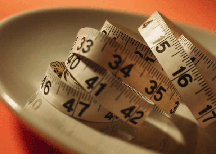 How do women determine if their weight might have negative effects on their health? According to the National Heart, Lung, and Blood Institute (NHLBI) guidelines, assessment of weight involves using three key measures:
How do women determine if their weight might have negative effects on their health? According to the National Heart, Lung, and Blood Institute (NHLBI) guidelines, assessment of weight involves using three key measures:
- Body mass index (BMI)
- Waist circumference
- Risk factors for diseases and conditions associated with obesity
Body Mass Index
BMI is a measure of weight relative to height. Waist circumference measures abdominal fat. By combining these measurements with information about any additional risk factors, women can calculate their risk for developing obesity-associated diseases.
BMI is a reliable indicator of “total body fat,” which is related to the risk of disease and premature death. You can find a simple online BMI calculator here. Simply enter your height and weight, and then use the following to estimate total body fat.
- Underweight BMI —below 18.5
- Normal BMI — 18.5-24.9
- Overweight BMI — 25.0-29.9
- Obesity BMI — 30.0 and higher
- Morbid obesity —BMI greater than 35.0
Waist Circumference
Women can determine waist circumference by placing a measuring tape snugly around their waist. It is a good indicator of abdominal fat, which is also a predictor of risk for heart disease as well as other health problems. This risk increases with a waist measurement of over 35 inches (88 cm) in women. Learn how to measure waist circumference here.
Assessment
Weight loss is recommended in the NHLBI guidelines for people who are obese (BMI 30.0 or more) or overweight (BMI of 25.0-29.9) and have two or more risk factors. The recommendation for people who are overweight, but have a normal waist measurement and fewer than two other risk factors, is to prevent further weight gain rather than to lose weight.
Healthcare providers can evaluate BMI, waist measurement, and other risk factors for heart disease. People who are overweight or obese need to know that they have a greater chance of developing high blood pressure, high blood cholesterol, or other lipid disorders, type 2 diabetes, heart disease, stroke, and certain cancers. They also need to know that even a small amount of weight loss (just 10% of current weight) will help lower the risk of developing diseases associated with obesity.
After risk factors are evaluated, the NHLBI helps women take the next step — from weight loss and physical activity to suggestions for a food diary, menu planner, and more.
Image credit: Copyright © Microsoft. Used with permission.